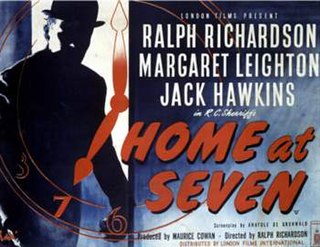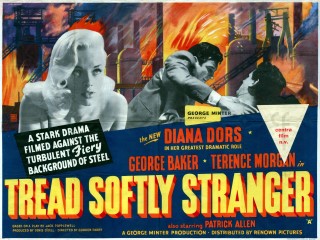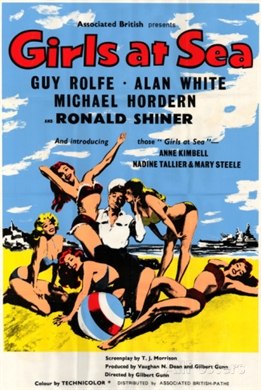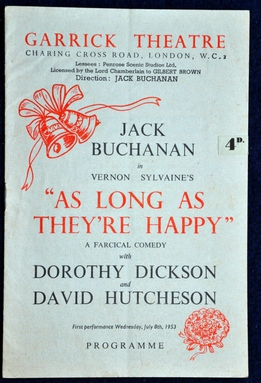
Walter John Buchanan was a Scottish theatre and film actor, singer, dancer, producer and director. He was known for three decades as the embodiment of the debonair man-about-town in the tradition of George Grossmith Jr., and was described by The Times as "the last of the knuts." He is best known in America for his role in the classic Hollywood musical The Band Wagon in 1953.

The Last Page, released in the United States as Man Bait, is a 1952 British film noir directed by Terence Fisher, starring George Brent, Marguerite Chapman and Diana Dors. The film was also known as Murder in Safety and Blonde Blackmail.

Not Now, Darling is a 1973 British comedy film directed by Ray Cooney and David Croft and starring Trudi Van Doorn, Leslie Phillips and Julie Ege. It was adapted from the 1967 play of the same title by John Chapman and Ray Cooney. The film is a farce centred on a shop in London that sells fur coats. A loosely related sequel Not Now, Comrade was released in 1976.

Dry Rot is a 1956 British comedy film directed by Maurice Elvey, and starring Ronald Shiner, Brian Rix, Peggy Mount, and Sid James.

Inn for Trouble is a 1960 black and white British comedy film directed by C.M. Pennington-Richards and starring Peggy Mount, David Kossoff and Leslie Phillips. It was a spin-off of the 1950s ITV sitcom The Larkins. The film is notable for the final credited appearances of Graham Moffatt and A. E. Matthews.

Ladies Who Do is a 1963 British comedy film directed by C. M. Pennington-Richards and starring Peggy Mount, Robert Morley and Harry H. Corbett.

Dancing with Crime is a 1947 British film noir film directed by John Paddy Carstairs, starring Richard Attenborough, Barry K. Barnes and Sheila Sim. A man hunts down the killer of his lifelong friend.

Piccadilly Incident is a 1946 British drama film directed by Herbert Wilcox and starring Anna Neagle, Michael Wilding, Coral Browne, Edward Rigby and Leslie Dwyer.

Home at Seven is a 1952 British mystery drama film directed by and starring Ralph Richardson, featuring Margaret Leighton, Jack Hawkins, Campbell Singer and Michael Shepley. It is based on the 1950 play Home at Seven by R. C. Sherriff. The film is Richardson's only work as director. Guy Hamilton was assistant director.

Manuela is a 1957 British drama film directed by Guy Hamilton, starring Trevor Howard and Elsa Martinelli. It was released as Stowaway Girl in the United States.

Home to Danger is a 1951 British second feature film noir crime film directed by Terence Fisher starring Guy Rolfe, Rona Anderson and Stanley Baker.

Treasure Hunt is a 1952 British comedy film directed by John Paddy Carstairs and starring Martita Hunt, Jimmy Edwards, Naunton Wayne and Athene Seyler. It is based on the 1949 play Treasure Hunt by Molly Keane and John Perry.

Mrs. Gibbons' Boys is a black and white 1962 British comedy film directed by Max Varnel and starring Kathleen Harrison, Lionel Jeffries and Diana Dors. It is based on the play of the same name by Joseph Stein and Will Glickman, and was released in the UK as the bottom half of a double bill with Constantine and the Cross (1961).

A Touch of the Sun is a 1956 British comedy film directed by Gordon Parry and starring Frankie Howerd, Ruby Murray and Dennis Price.

Tread Softly Stranger is a 1958 British crime drama directed by Gordon Parry and starring Diana Dors, George Baker and Terence Morgan. The film was shot in black-and-white in film noir style, and its setting in an industrial town in northern England mirrors the kitchen sink realism movement coming into vogue in English drama and film at the time. The screenplay was adapted from the stage play Blind Alley (1953) by Jack Popplewell.

Girls At Sea is a 1958 British comedy film directed by Gilbert Gunn and starring Guy Rolfe, Ronald Shiner, Alan White, Michael Hordern and Anne Kimbell. It was based on the 1930 play The Middle Watch by Ian Hay and Stephen King-Hall, previously filmed as The Middle Watch in 1930 and under the same title in 1940.

The Gang's All Here is a 1939 British black-and-white comedy-mystery, directed by Thornton Freeland and starring Jack Buchanan and Googie Withers. It was produced by Associated British Picture Corporation and released in the U.S. in 1943 as The Amazing Mr. Forrest.

Hi Gang! is a 1941 British comedy film directed by Marcel Varnel and starring Bebe Daniels, Ben Lyon and Vic Oliver. It was a spin-off from the popular BBC radio series Hi Gang!.
Vernon Sylvaine (1896–1957) was a British playwright and screenwriter. He is known for writing several popular stage farces. He began working in film in 1937 when his stage hit Aren't Men Beasts! was turned into a film of the same title starring Robertson Hare and Alfred Drayton. Hare and Drayton starred in two further adaptations of his plays A Spot of Bother (1938) and Women Aren't Angels (1943). He adapted his own play for the 1943 comedy-thriller Warn That Man starring Gordon Harker, Basil Radford and Judy Kelly. His 1948 play One Wild Oat was turned into a 1951 film of the same title.

As Long as They're Happy is a comedy play by the British writer Vernon Sylvaine which was first staged in 1953. A successful hit, it ran at the Garrick Theatre in the West End for 370 performances between July 1953 and May 1954. Veteran entertainer Jack Buchanan directed and starred as a stockbroker trying to cope with the extravagant behaviour of his daughters. Other members of the cast included Dorothy Dickson, Nigel Green, David Hutcheson and Stephen Hancock.



















